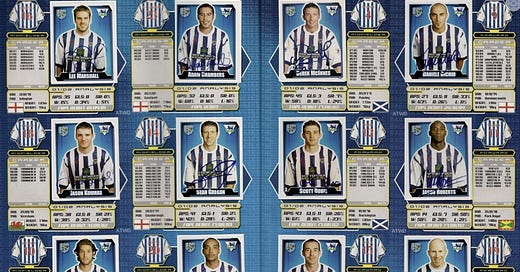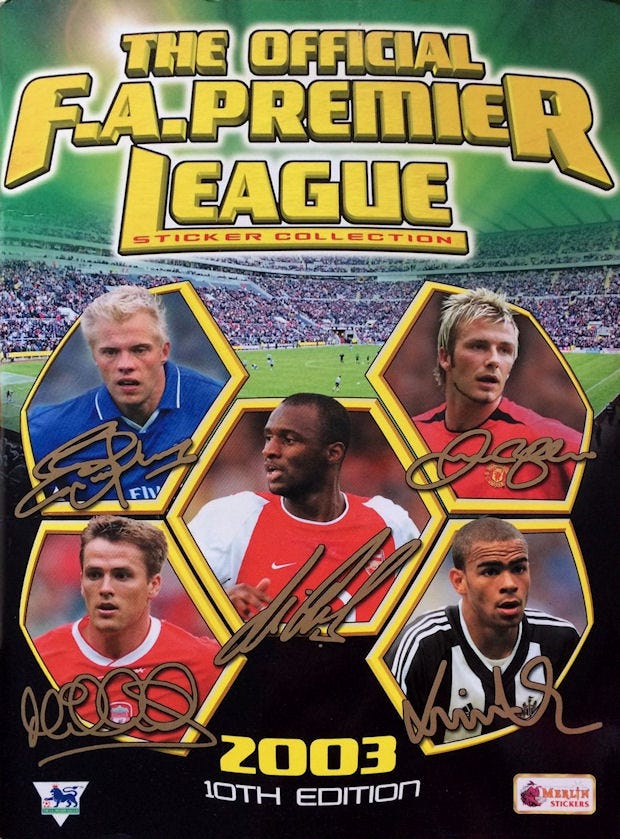Merlin Magic: the charismatic power of football stickers
What forces lie behind the unique nostalgia of football sticker albums?
A few weeks ago whilst rifling through some boxes of childhood nik-naks at my family home, I was struck by a lightning bolt of sentimentality.
A flash of green, the smooth feel of glossy card against my fingers, the unmistakable visage of Eiður Guðjohnsen staring through me. Here in my hands, for the first time in 20 years, was my 2003 Official Merlin Premier League Sticker Album – in all its dilapidated glory.
As I started flicking through the fraying pages, I was instantly struck by the album’s unique charisma. More so than any other childhood relic I found in that old box, my sticker collection immediately imbued me with a deep, mawkish sense of joy.
The huge emotionality of this encounter with my footballing past soon had me percolating on a question: what makes football stickers such a profound source of nostalgia for football supporters such as myself?
The charisma of material culture – or rather the power of physical objects to rouse a sense of awe, wonder or emotion in humans – has been one of the central pre-occupations of heritage scholars such as myself since the inception of modern heritage research.
Traditionally, objects that are categorised as heritage have been understood as having intrinsic value. This idea is central to leading heritage management bodies such as UNESCO. The notion of intrinsic value promotes the idea that the charisma of an object is somehow linked to the essence of the object itself. In other words, some objects are just naturally charismatic, and this charisma is universally recognisable to humanity.1
However, over the last 20 years this view has been challenged as scholars have coalesced around the rather postmodern idea that objects have no intrinsic value at all.2 Rather, the affective power any object lies in the eye of the beholder. As argued by Vedeler, the charismatic power of objects is rooted in the stories, myths and legends different communities attach to them. In other words, objects are charismatic because of the values we project onto them and the experiences they come to represent or encapsulate.3
As we attempt to decode what makes my sticker album such a powerful source of nostalgia, this argument moves the focus away from trying to unpick the intrinsic charismatic qualities of the album. Rather, attention must turn to the unique stories the sticker album allows me – and other football fans like me - to tell.
One alluring interpretation of the album is that its charisma lies in the fact it represents one of football’s great historical traditions: collecting.
Football collectables have been widespread since the late 19th century – most notably in the form of cigarette cards – making collecting a tradition firmly rooted at the birth of football culture in the UK.
Crucially, sticker collecting is one of the most historically popular and widespread expressions of fandom in the history of the game. During the 1980s peak of sticker collecting, 9 out of 10 schoolchildren in the UK were buying football stickers in some form, with Panini selling 100 million stickers per season in the UK market alone.4
Certainly, flicking through the pages of the album evokes incredibly strong memories of the unique football sticker culture that existed on the playgrounds when I was a child.
Despite the fact I was collecting in the early 00s, a period of particular lull in the popularity of football stickers, there was still a unique buzz on the playground as the collectors brought out their bundles of duplicates wrapped in elastic bands. There was still the unique language that existed around the playground sticker economy – from “shinys” to “dupes”. And of course, there was still the special ritual of “got, got, need”, the uniquely exciting act of flicking through piles of stickers in a bid to ascertain the individual stickers you wanted to complete your collection.
The album also tells a story of education. Indeed, the wider story of sticker collecting in the UK is a story of the unique learning experience sticker collecting provided generations of football supporters.
For us, sticker collecting offered a tantalising portal to football history and the wider world during crucial formative years. It was crucial conduit through which I fleshed out my knowledge of English football and its cast of characters. In this sense, my Merlin album acted as a sort of DIY biblical text, a sherpa which guided me through my early explorations of football, culture and geography.
The designated shiny stickers and star players sold me on the unique talents of different players. The “team profile” pages filled in the historical knowledge I needed in order to contextualise any game I watched. My album was also instrumental in fleshing out my love of geography and sense of wanderlust I carry with me to this day. The huge array of flags throughout the album - each representing the home country of every single player in the Premier League - was the catalyst for me to start getting to grips with the myriad cultures of the wider world.
But if these interpretations may hint at why sticker albums stoke nostalgia amongst football supporters in general, for me – and I suspect thousands of supporters like me – the true charisma of the album lies in something much more personal.
I started this article by suggesting the heritage value and charisma of any object lies in the eye of its beholder. More to the point, I suggested that objects take on a charismatic quality because of their particular stories we project through them.
Against this context, the nostalgia my sticker album imbued me with was less about my involvement in an antiquarian collecting tradition or the album’s educative power.
Quite simply – the act of rediscovering my sticker album transported me back to an innocent, irretrievable moment of time.
As I sat on the floor flicking through the tattered old pages of my album, I was once again an excited six year old bounding around to the local corner shop, with 20p burning a hole in my pocket as I chased that much coveted Joe Cole shiny.
I was reliving a time in my life when football was an all-encompassing source of joy. It was a time when football was accessible and firmly rooted in the analog. I was surrounded by friends with whom I played every lunchtime and school night. Kids tickets to matches cost a quid, a packet of stickers mere pocket pennies.
As I have aged – and indeed as football culture has commercialised, gentrified and become imbricated with geopolitics – that innocent love has been replaced with a more critical faculty.
Against this context, my album symbolises a moment when football retained its sense of mystery. The exhausting reality of 24-hour sports news and online perma-discourse was still a decade from fruition. I retained the ability to engage with football with a genuine sense of childlike wonder. The gaps in my understanding were filled by a logic of mysticism and magic, rather than economics, geopolitics or cynicism.
I would suggest that through my rediscovery of my sticker album, we can start to see and understand the process by which relics of the footballing past become imbued with a deep charisma.
My deeply emotional reaction to the album was rooted in a personal narrative of reclamation. Through my nostalgic interactions with the album, the object itself took on a metonymic property, symbolising and recapturing a moment in time when my love of football was totally uncomplicated.
Though I find my sticker album an aesthetically beautiful, deeply romantic relic of the footballing past, the power it holds over me lies not in the essence of its tattered old pages. Rather, like any charismatic object, its affect is rooted in the values and narratives I project onto it and through it.
So – to return to the original question - what makes football stickers such a profound source of nostalgia for football supporters such as myself?
It is because they are relics of the footballing past as experienced by supporters. It is because they are products and symbols of memory. And it is because they represent stories that are meaningful to those who collect them.
UNESCO (2017) Operational Guidelines for the Implementation of the World Heritage Convention. Article 49-50.
Carman, J. (2002) Archaeology and Heritage: An Introduction. London: Continuum. p. 11.
Vedeler, M. (2018) 'The Charismatic Power of Objects' in Vedeler, M., Røstad, I.M., Kristoffersen, E.S., Glørstad, Z. T. (eds.) Charismatic Objects: From Roman Times to the Middle Ages. Oslo: Cappelen Damm A.S., pp. 10-13.
Lansdowne, G. (2021) Panini Football Stickers: The Official Celebration: A Nostalgic Journey through the world of Panini. London: Bloomsbury. pp. 24-26.









Absolutely love posts like this. So interesting. I have a similar relationship with early FM in terms of learning the footballing landscape. Nostalgia for what unlocked an interest is powerful